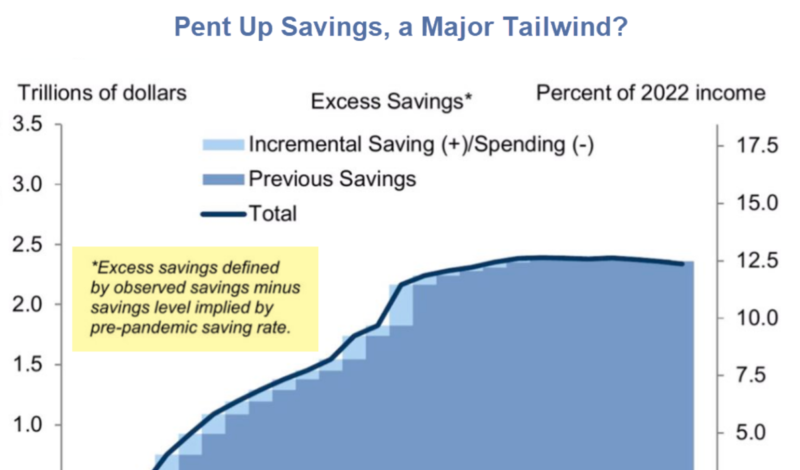Is there a big pool of unspent fiscal stimulus money that will support consumption going forward?

The lead images is from a Tweet.
“Not sure most investors appreciate how much it will take to eat through the excess savings & healthy balance sheets that the pandemic created for households as a whole. Because people don’t understand flows and balances. The excess savings is a balance. The savings rate a flow,” says Wasteland Capital.
Excess Savings?!
In Austrian economics “excess savings” is impossible. It implies no one would consume, thus we would all starve to death.
The Austrians are correct, but let’s discuss an alternate definition as provided.
“Excess savings = the cumulative savings above the pre-pandemic amount.”
How Much Free Money Stimulus Still Hasn’t Been Spent?
Without using the term “excess savings” I took a stab at the above definition on April 22 in How Much Free Money Stimulus Still Hasn’t Been Spent?
Chart Notes
- SAAR stands for seasonally-adjusted annualized rate.
- The three rounds of free money stimulus in April of 2020, January of 2021, and March of 2021 are clearly visible.
- Stimulus generated inflation. But how much still isn’t spent?
The above chart is two month old, so let’s do an update, this time looking at real (inflation adjusted income and spending.
Real Disposable Income and Spending
Big Excess?
Don’t be so sure.
Free money that goes to bottom rung households tends to immediately get spent. The higher the rung, the longer the savings remain unspent. This is complicated by the fact that most of the money was supposed to go to lower tiers, and further complicated by corporate fraud, especially in round one.
More importantly, personal spending does not count down payments on homes, mortgage paydowns, stock market or Bitcoin purchases, capital expenses for businesses, drug money, other illegal uses, or money sent to relatives overseas.
Paying down debt is also saving. Money paying down credit card bills also constitutes saving.
Crypto Heaven
The notion that there is a big pool of accumulated savings ready to spend for months into the future is very questionable.
I have a sneaking suspicion that much of the allegedly unspent money went to crypto heaven or the stock market.
Point of clarification: The money did not go to money heaven, someone still holds every dollar.
It’s wealth that went to money heaven.
Q: What is “saving”?
A: Production Minus Consumption
We handed out free money with nothing being produced then we wonder why we have inflation!
Evidence Suggests the Money Already Spent
On May 17, I noted Retail Sales Easily Beat Expectations, US Treasury Yields Jump in Response
However, the next day I noted Target Plunges 25%, What About Yesterday’s Big Retail Sales Blowout?
Reports by Target and Walmart strongly suggest something other than pent-up saving.
Target Key Points
- Higher markdowns
- Inventory impairments
- Lower than expected sales in discretionary items
- Inability to raise prices
Walmart also warned about bloated inventories.
Amazon is laying off workers.
Discretionary Spending Exaggerated
Credit Card Debt and a 3-Way Crash
Expect a Recession
Consumers are in such great financial shape they went on a credit card binge instead of spending alleged savings.
If there is a “tailwind” of savings, which I rather doubt, it will be consumed in a flash in the coming recession.
When is that?
I Expect a Deep Recession to Start This Quarter or Early Third Quarter
That triggered a silly discussion on Twitter noting this month is the end of the second quarter. Yes, that’s true but most key data is still from April.
Jobs are a very lagging indicator. They rose in the first quarter of the Great Recession and in many preceding months.
The key number is retail sales. The most recent data is April. It was way stronger than expected. But is it believable?
This article was originally published by Mish Talk.







